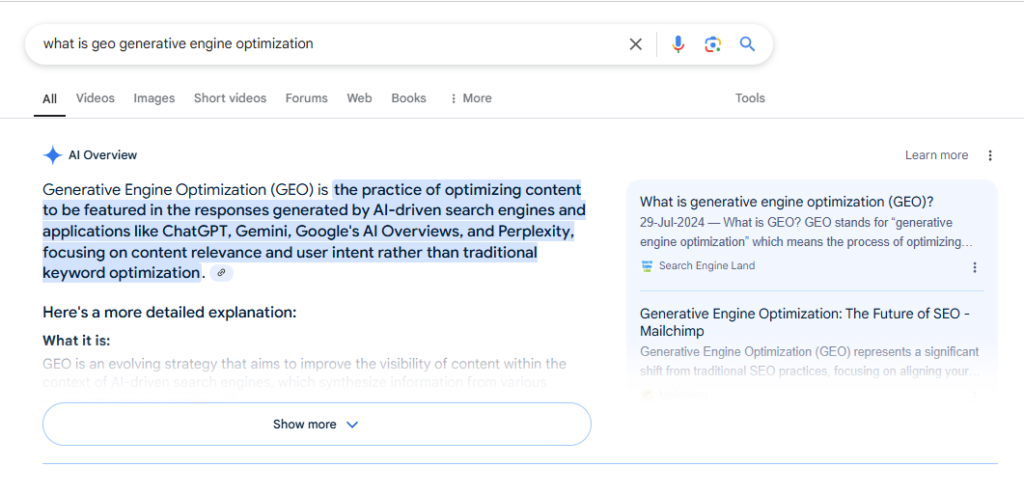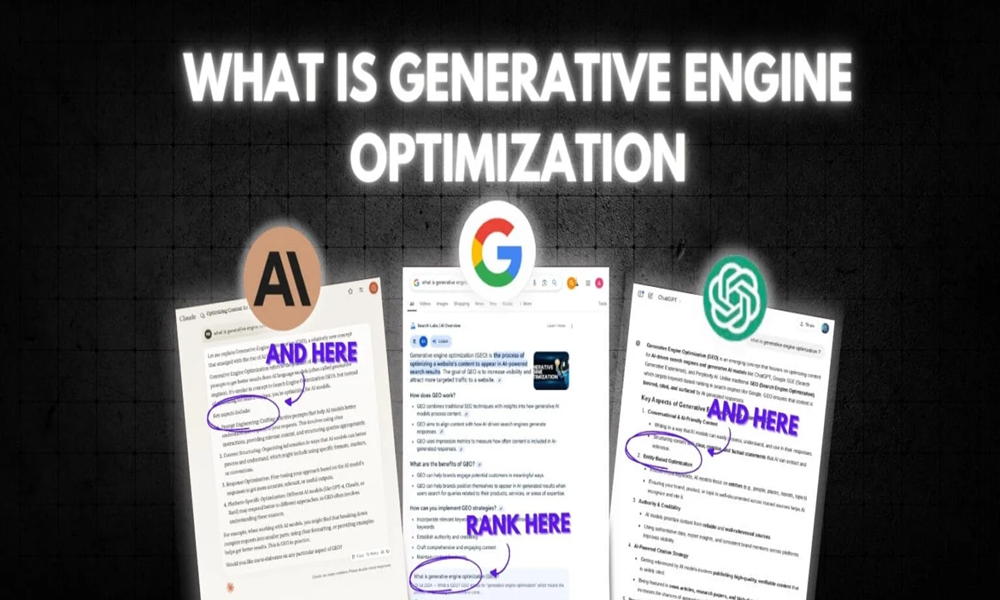Generative Engine Optimization (GEO) is one of the most critical and important SEO trends that we all need to start implementing right now. It represents a significant adaptation of conventional SEO strategies to the new paradigm known as Google Search Generative Experience (GSE).
Google SGE is a new way Google search results pages are displayed. It’s no longer the typical SERP with a list of sites sorted by relevance from top to bottom. Now, Google has incorporated generative artificial intelligence that can generate a direct response to the user’s query.
We can better understand this with the following Google query example: “ zero-click searches .”
Traditionally, we would see a results page starting from the websites. From now on, because of Google SGE , we will start seeing results like this:

If you want to start seeing these types of results, you can activate Google SGE whenever you want, although it’s currently only available in certain countries and languages.
As you’ll see, this situation completely changes the rules of SEO , as users can satisfy their need for information instantly, without having to click on any search results. This is known as “zero-click searches.” Consequently, organic traffic even from the “top-ranked” site plummets.
The good news is that, as you can see in the image above, within those responses, generative AI often shows the sources it used to produce the summary. In this context, it’s interesting to note that 93.8% of the sources cited in SGE results come from sites that aren’t ranked in the top 10 organic results , according to a study on Google SGE and organic search results .
This means that even having very good rankings thanks to traditional SEO strategies doesn’t guarantee that you’ll appear in Google SGE citations . This raises the question:
“If they’re not the best SEO- optimized sites , then where do the sites that are cited by Google’s AI come from? ”
The answer is simple: sites that implement GEO optimization , even though they may be far down in traditional organic results.
Thus, GEO strategies in SEO aim to help you appear as a cited source of information within AI responses, without having to rank in the top 10 organic results.
With all of the above in mind, the 4 best GEO strategies to improve your visibility on Google are the following :
GEO Strategy #1: What do AI experts and researchers recommend?
We’re not going to start with a single strategy, but with a set of techniques that are already considered the most fundamental GEO best practices .
To date, one of the most important research projects on SGE worldwide is titled GEO: Generative Engine Optimization , which was conducted by experts in large language models ( LLM ) from Princeton University, Georgia Tech, The Allen Institute for AI and ITT Delhi .
According to this study, the best GEO practices that serve to increase visibility in Google SGE are:
- Use of citations: This involves including relevant pieces of external information that add value to the content and come from reputable sources. For example, statements from prominent figures. This makes the content more credible.
- Citing sources: Following the same idea as the GEO factor above, it’s important to cite reliable sources of information that allow for verification of the information presented in the content. This increases the credibility of the text and is especially valuable when publishing content that answers factual questions.
- Use of statistics: You should support your content with quantitative data as much as possible, rather than limiting it to purely qualitative ideas. Adding hard, statistical data (such as percentages, financial figures, etc.) lends credibility to your texts. This is particularly useful for search queries related to factual information (facts, ratings, dates, quantities, formulas, etc.).
- Authority: Sentences should be written in a persuasive manner that conveys confidence, experience, and assertiveness. The goal is to give the reader the feeling that the content comes from an authority on the subject, with enough knowledge to speak on the subject in an expert tone.
Evaluations of GEO optimization methods - Optimizing for flow : Google’s AI not only values content enriched with citations, sources, and statistics, but also the way and style in which that content is presented. Both the text and the order of ideas need to flow. The transition from one sentence to the next should be natural.
- Ease of understanding: In line with the previous GEO criterion , it’s important to maintain clear, simple, and engaging language that allows for quick understanding by the reader. The simpler the text, the better, as long as the quality and depth of the information are not sacrificed.
- Use of technical terms: Flow and simplicity in the text are not the enemy of technical words. Quite the opposite. Content should be supported with technical terms and concepts whenever necessary, depending on the nature of the topic being discussed. These allow for a greater level of expertise, depth, and credibility, while also helping to enhance the content’s understanding.
GEO Strategy #2: Develop EEAT content
EEAT stands for several SEO criteria that allow Google to identify when content is high-quality and when it isn’t. As a GEO strategy , these factors take on special relevance, since generative AI typically uses only content that demonstrates its proven writing to fully meet user needs as information sources.
Therefore, it’s important to understand that these needs are not only related to the information in the content itself, but also to the site’s reputation, the author’s reliability, the protection of your data, etc.
That said, the EEAT criteria in English are: Experience, Expertise, Authoritativeness and Trust.
Google EEAT Quality Assessment Guidelines
Let’s see what they consist of:
- Expertise: This is your ability to demonstrate practical, direct knowledge of a specific topic. Google looks for signals to determine if you have real, personal experience with the topic you’re writing about.
- Expertise: This goes beyond your personal experience, as this criterion focuses on your level of specialized knowledge in a specific field. Similarly, Google looks for signals to detect whether your published content is 100% relevant to the topic your blog specializes in or if, on the contrary, you’re writing about other topics outside your field.
- Authority: Authority is based on your reputation as an author or your website’s reputation as an information portal. This is built when other experts or trusted sources in a field recognize or cite your content or website. This is where backlinks , mentions in respected publications, or any other form of recognition that shows you’re a reference in your field come into play.
- Trustworthiness: This factor relates to your site’s credibility. Google determines whether your site is trustworthy if the information you publish is accurate and transparent, if you cite reputable sources, and if you guarantee the security and protection of user data.
GEO Strategy #3: Zero-Click Content
In recent years, zero-click searches have been around, posing significant challenges for SEO optimization . As we mentioned earlier, these types of results provide users with a direct answer, so they no longer have as much need to visit websites that appear in the SERPs .
Nowadays, zero-click searches are set to become much more widespread thanks to Google’s SGE . However, they no longer function as they did before, as the way Google processes and displays these results has radically changed due to artificial intelligence.
As you can see, traditional zero-click searches show a summary from a single source of information, which can be considered the best-ranked website and which can have very good CTR levels or click-through rates.
As you can see in this new case, zero-click searches no longer come from a single website; instead, the results are now generated by Google’s artificial intelligence. In fact, if you click on the three dots next to the message ” Generative AI is experimental. Learn more ,”
For both traditional zero-click searches and Google SGE , you can implement two GEO strategies to improve your visibility and positioning:
Creating zero-click content: This involves developing and optimizing content that meets the requirements to appear in featured snippets, direct answer boxes, knowledge graphs, and other Google quick response formats. To do this, you should do the following:
-
- Research and answer frequently asked questions for each search intent
- Structure your content so that it answers specific questions.
- Include lists, tables, steps, and definitions in your content.
- Implement Schema markup to optimize your structured data.
Focus on keywords that aren’t zero-click: Currently, neither traditional zero-click searches nor Google SGE are standardized for all keywords. For now, and for a while, this will give you a good margin of maneuver. Something that many companies are doing, and that has worked very well for them, is identifying which keywords trigger zero-click searches. Once identified, they then focus their content creation on other keywords that don’t generate zero-click results.
This way, they manage to stay competitive on conventional search results pages, where websites continue to appear in order of authority. This basically involves traditional SEO optimization .
GEO Strategy #4: Respond to long-tail queries
Generative Engine Optimization goes hand in hand with Voice Search Optimization , so voice search optimization practices are also very good GEO strategies .
It’s important to keep in mind that more and more users are becoming accustomed to voice searches using the microphone in browsers, virtual assistants, smart speakers, etc. Because it’s easier to do without typing words, there’s been an accelerated increase in long- tail queries, which are characterized by being long, detailed, and highly descriptive. In other words, they’re conversational queries , just as if the user were talking to another person.
Therefore, Google’s generative AI and voice search engines prioritize content that is written in a very natural and conversational manner , capable of responding with the same tone and style with which the queries are formulated.
In this context, an excellent GEO technique is to create content targeted at long-tail search phrases . To do this, we recommend doing the following:
- Identify the most potential long-tail queries: Use SEO tools like Answer The Public , which allows you to find out all the main questions that usually revolve around a particular keyword or topic.
Long-tail question chart for SEO and GEO
- Understand the user’s intent and need : For each long-tail keyword, try to understand the user’s underlying need. This will help you create content that addresses not only their questions but their specific needs.
- Create specific and detailed content : The content should be deeply relevant to the long-tail keyword. It provides useful information, tips, step-by-step guides, or detailed answers to specific questions. The goal is to be the best source of information on that specific topic.
Read More: Ultimate SEO Checklist 2025: Optimize Your Site for Google
Conclusion
Finally, under this new Google approach, traditional SEO optimization is no longer enough . You need to implement GEO techniques that allow you to improve both your SERP ranking and your visibility within the generative AI response. However, beyond this, it’s also important to improve your website’s user experience and conversion methods as much as possible . Many sites are likely to see a decrease in organic traffic, so they must make the most of those visitors who do manage to reach their site.
Saad Raza is an SEO specialist with 7+ years of experience in driving organic growth and improving search rankings. Skilled in data-driven strategies, keyword research, content optimization, and technical SEO, he helps businesses boost online visibility and achieve sustainable results. Passionate about staying ahead of industry trends, Saad delivers measurable success for his clients.


